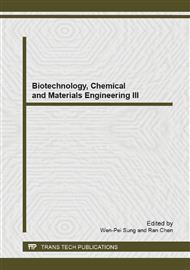p.522
p.526
p.531
p.535
p.540
p.544
p.548
p.553
p.556
The Application of PCR-DGGE Technique in Sheep Intestinal Microbial Diversity Research
Abstract:
To identify the intestinal microflora diversity of transgenic sheep and non-transgenic one with overexpression of foreign antiviral gene (VP1 & SB-SW), DNA of total bacteria were extracted from 16 sheep fecal samples (4 non-transgenic sheep, 6 VP1 transgenic sheep and 6 SB-SW transgenic sheep). And then PCR amplification with bacterial universal primers of V3 variable region of 16S rRNA were taken to get the fingerprint profile by denaturing gradient gel electrophoresis (DGGE) technology. The results showed that the DGGE profiles of the 16 fecal samples were highly polymorphic. The number of DGGE bands, considered indicative of the total species richness, did not vary predictably among the three different samples. The DNA sequences were analyzed and the dominant bacteria in sheep fecal were found to be Bacteroides, Clostridium, and Ruminococcus. Specially, non-transgenic sheep had more Alistipes finegoldii and Clostridium lentocellum, transgenic sheep with VP1 had more Clostridium drakei and Clostridium populeti and transgenic sheep with SB-SW had more Barnesiella intestinihominis and Clostridium ljungdahlii. So the PCR-DGGE technique can be applied to evaluate genetically modified (GM) animal potential risks to the environment.
Info:
Periodical:
Pages:
540-543
Citation:
Online since:
January 2014
Authors:
Keywords:
Price:
Сopyright:
© 2014 Trans Tech Publications Ltd. All Rights Reserved
Share:
Citation:


